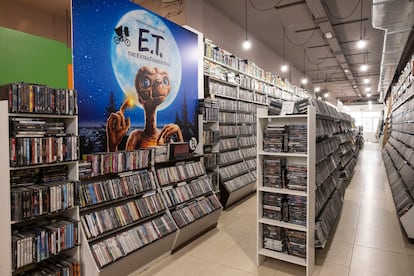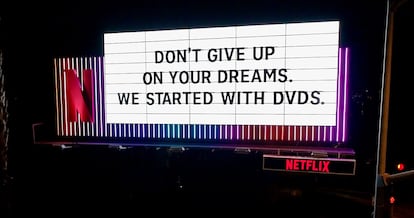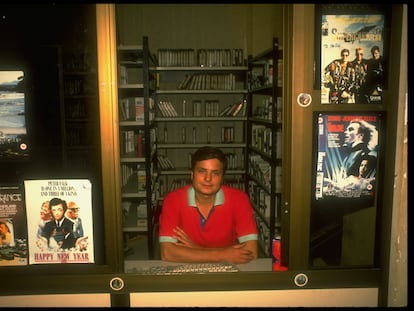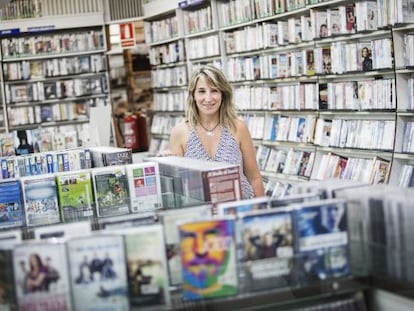Be kind, rewind: The video store generation clings to its past
VHS and DVD fans defend physical media against streaming giants like Netflix, who discontinued their 25-year DVD rental service last year


From the forgettable Netflix film Leave the World Behind, one redeeming aspect stands out: a teenager finds solace in a luxury doomsday bunker filled with DVDs, including her favorite TV series, Friends. Amid a world in turmoil from some mysterious technological chaos, the discovery of this old-school video format sparks hope for the girl. Oddly enough, this movie nod came shortly after Netflix — the platform known for DVDs — bid farewell to its mail rental service after 25 years. The streaming giant announced the closure of DVD.com last spring, citing declining business and service quality concerns. To mark the occasion, Netflix displayed slogans on Sunset Boulevard billboards like “DVDs will always be in our DNA” and “Don’t give up on your dreams. We started with DVDs.”
The barrage of propaganda couldn’t stem the steady stream of articles bemoaning Netflix’s closure of its DVD-by-mail service. It wasn’t just for sentimental reasons. Many Americans in remote areas with poor internet access relied on DVD.com for movies and TV series. The news came as a shock to many – it felt like the unexpected death of a forgotten Hollywood star. Since 1998, the service had distributed over 5.2 billion titles to four million users in the United States.

According to Netflix, the last movie mailed out was True Grit, the 2010 Western by the Coen brothers starring Jeff Bridges. In the final year of the mail service, the most rented movie was Top Gun: Maverick, except in Washington D.C. where Tár was the top choice, possibly due to the local power dynamics as the film features an abusive orchestra conductor. Cate Blanchett led with 44.2 million rentals as the most rented actress, surpassing Meryl Streep by two million. Clint Eastwood was the most rented director, with Gran Torino as his top film. Directors Steven Spielberg and Martin Scorsese followed in second and third place. The most popular film of the 1920s was Metropolis by Fritz Lang.
Columnist Melinda Delkic noted in The New York Times a common problem in the vast world of streaming services: thousands of movies are simply hard to find, like Crossroads (2002), starring Britney Spears. This issue raises questions about the accessibility of content over time. Additionally, the challenge extends beyond the availability of films to encompass obsolete players that eventually stop working.
DVD replaced VHS in 1996 and its decline started in 2008 due to the great recession and the rise of Blu-ray. Platforms like Free Blockbuster for sharing VHS, DVD and Blu-ray are now thriving. Nostalgia for video stores is growing, embraced even by film legend François Truffaut, who in the early 1980s welcomed the new format by saying, “Since I’m a cinephile, I’m a video lover.” With movies now accessible to all, the artistic language of films also changed for an entire generation of creators like Quentin Tarantino who grew up on videos.

Kim’s Video is a good example of the far-reaching influence of the medium. It’s a somewhat haphazard documentary about New York’s best video store, a place that housed more than 55,000 VHS tapes and DVDs, including a significant collection of very obscure and underground films. When it closed in 2008, the collection was sent to Sicily, where all sorts of bizarre events unfold involving the Sicilian mafia, the controversial Vittorio Sgarbi (an art critic and until recently the Italian Culture Minister) and a group of rabid fans who learned about life from the shelves of Kim’s Video.
Aurora Depares owns Spain’s oldest video store, Video Instan, established in Barcelona 43 years ago. With 47,000 films, the business underwent a transformation in 2018. Faced with the rise of streaming platforms and video store closures, they expanded to include a café and a private viewing area. Today, they serve 250 clients who play a flat monthly rate of €9.95 ($10.85), as well as collectors and film scholars drawn to their extensive collection. “My parents bought everything released in Spain,” said Depares. “We’ve got all you want, plus 7,000 VHS movies that you won’t find on DVD or Blu-ray. Our goal is to protect and maintain this legacy. I grew up in the video store era; no streaming platforms for me. It’s either the movie theater or DVDs. The video store encourages socializing because you have to browse the shelves. You end up talking about movies with other customers, which doesn’t happen when you’re scrolling on the couch.”
New Yorker critic Richard Brody noted that even top platforms for cinephiles like The Criterion Channel and Filmin remove movies from their catalog after a while. Brody sees physical formats not as nostalgia, but as rebellion — owning your own collection is a way of resisting the control of big streaming companies. “Far from being nostalgic and conservative, the maintenance of a stock of physical media at home is a progressive act of defiance.”
We might be witnessing a resurgence of the medium akin to the vinyl record album revival, or it could simply be the final bow of a format that has even become the subject of movies, like the wonderful Be Kind, Rewind (2008). In Michel Gondry’s comedy, rapper Mos Def and Jack Black portray cinema as an expression of love and shared memory, taking charge of a video store on the brink of closure.
Sign up for our weekly newsletter to get more English-language news coverage from EL PAÍS USA Edition
Tu suscripción se está usando en otro dispositivo
¿Quieres añadir otro usuario a tu suscripción?
Si continúas leyendo en este dispositivo, no se podrá leer en el otro.
FlechaTu suscripción se está usando en otro dispositivo y solo puedes acceder a EL PAÍS desde un dispositivo a la vez.
Si quieres compartir tu cuenta, cambia tu suscripción a la modalidad Premium, así podrás añadir otro usuario. Cada uno accederá con su propia cuenta de email, lo que os permitirá personalizar vuestra experiencia en EL PAÍS.
¿Tienes una suscripción de empresa? Accede aquí para contratar más cuentas.
En el caso de no saber quién está usando tu cuenta, te recomendamos cambiar tu contraseña aquí.
Si decides continuar compartiendo tu cuenta, este mensaje se mostrará en tu dispositivo y en el de la otra persona que está usando tu cuenta de forma indefinida, afectando a tu experiencia de lectura. Puedes consultar aquí los términos y condiciones de la suscripción digital.
More information
Archived In
Últimas noticias
There is as much life left to discover on planet Earth as that which is already known
Dozens presumed dead, around 100 injured in fire at Swiss Alps bar during New Year’s celebration
Is porn for women different from conventional porn? We spoke to those who make it
Cartagena de Indias is sinking: What can the city do to mitigate it?
Most viewed
- Reinhard Genzel, Nobel laureate in physics: ‘One-minute videos will never give you the truth’
- Sinaloa Cartel war is taking its toll on Los Chapitos
- David King, chemist: ‘There are scientists studying how to cool the planet; nobody should stop these experiments from happening’
- Oona Chaplin: ‘I told James Cameron that I was living in a treehouse and starting a permaculture project with a friend’
- The Interoceanic Train, the Mexican alternative to the Panama Canal










































